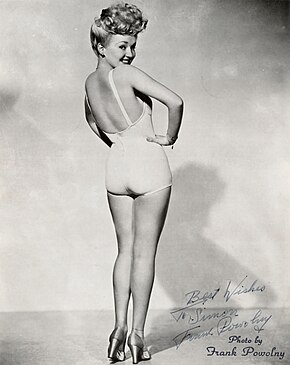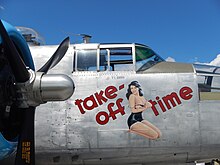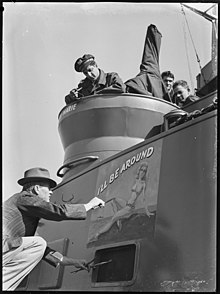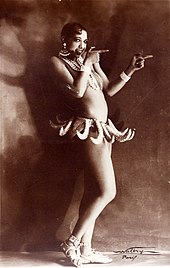Over the Hill Pin Up Girl Line Drawing Art

A pivot-upwards model (known as a pivot-up girl for a female person and less normally male pin-upwards for a male) is a model whose mass-produced pictures come across widespread appeal as part of pop civilization. Pin-up models were variously glamour models, mode models, or actresses whose pictures were intended for informal display, i.eastward. meant to be "pinned-up" on a wall, which is the basis for the etymology of the phrase. These pictures are likewise sometimes known as cheesecake photos.[a] Cheesecake was an American slang give-and-take that became a publicly acceptable term for scantily-clad, semi-nude, or nude photos of women considering pivot-up was considered taboo in the early 20th century.[1] [ dubious ]
The term pin-upward may refer to drawings, paintings, and other illustrations also as photographs (encounter the list of pin-up artists). The term was first attested to in English in 1941[2] fifty-fifty though the do is documented at least back to the 1890s. Pin-up images could exist cut out of magazines or newspapers, or they could be on a postcard or lithograph. Such pictures often appear on walls, desks, or calendars. Posters of these types of images were mass-produced and became popular starting from the mid-20th century.
Male person pin-ups (known as beefcake) were less common than their female counterparts throughout the 20th century, merely they take ever been around. In particular, pictures of pop male celebrities were targeted at women or girls; examples include James Dean and Jim Morrison.
History [edit]

Pivot-up girl nose art on the restored World War II B-25J aircraft Take-off Time
Beginning in the early 19th century, pin-up modeling had "theatrical origins"; caricatural performers and actresses sometimes used photographic ad every bit business cards to annunciate shows. These promotion and business cards could often exist constitute backstage in almost every theater's green room, pinned-upward or stuck into "frames of the looking-glasses, in the joints of the gas-burners, and sometimes lying on-top of the sacred cast-case itself."[3] "To understand both the complicated identity and the subversive nature of the 19th-century actress, one must likewise understand that the era's views on women's potential were inextricably tied to their sexuality, which in turn was tied to their level of visibility in the public sphere: regardless of race, form or background, information technology was more often than not assumed that the more public the adult female, the more 'public,' or bachelor, her sexuality", according to historian Maria Elena Buszek. Being sexually fantasized, famous actresses in early-20th-century motion-picture show were both drawn and photographed and put on posters to exist sold for personal amusement.[4] Among the celebrities who were considered sex symbols, ane of the almost popular early pin-up girls was Betty Grable, whose poster was ubiquitous in the lockers of G.I.s during World War II.
In Europe, prior to the Get-go Globe War, the likes of "Miss Fernande" (who some place as Fernande Barrey[five] [6]), were arguably the world's first pivot-ups in the modern sense. Miss Fernande displayed aplenty cleavage and full frontal nudity, and her pictures were cherished by soldiers on both sides of the Start Earth War conflict.

Harry Wann[ who? ] paints a "pin-up" girl on a PT boat, Australia, 1944
Other pivot-ups were artwork depicting idealized versions of what some thought a particularly cute or attractive woman should look like. An early case of the latter type was the Gibson Girl, a representation of the New Adult female fatigued by Charles Dana Gibson. "Because the New Woman was symbolic of her new ideas about her sex, it was inevitable that she would also come up to symbolize new ideas virtually sexuality."[vii] Unlike the photographed actresses and dancers generations earlier, fantasy gave artists the freedom to draw women in many different ways.[8] The 1932 Esquire "men's" mag featured many drawings and "girlie" cartoons but was almost famous for its Vargas girls. Prior to Globe War II they were praised for their beauty and less focus was on their sexuality. However, during the war, the drawings transformed into women playing wearing apparel-up in military elevate and drawn in seductive manners, like that of a child playing with a doll.[ix] The Vargas girls became then pop that from 1942–46, attributable to a high volume of military demand, "ix 1000000 copies of the magazine-without adverts and free of charge was sent to American troops stationed overseas and in domestic bases."[10] The Vargas Girls were adapted as nose fine art on many World War II bomber and fighter shipping; Generally, they were considered inspiring, and not seen negatively, or as prostitutes, but mostly equally inspiring female person patriots that were helpful for good luck.[11]
Among the other well-known artists specializing in the field were Earle Chiliad. Bergey, Enoch Bolles, Gil Elvgren, George Lilliputian, Rolf Armstrong, Zoë Mozert, Duane Bryers[12] and Art Frahm. Notable gimmicky pin-upward artists include Olivia De Berardinis, known for her pivot-up art of Bettie Page and her pieces in Playboy.
Feminism and the pivot-up [edit]
Buszek[ who? ] said that the pivot-upwardly girl "has presented women with models for expressing and finding pleasure in their sexual subjectivity".[13]
According to Joanne Meyerowitz in "Women, Cheesecake, and Borderline Material" an article in Journal of Women'south History, "Every bit sexual images of women multiplied in the popular civilisation, women participated actively in amalgam arguments to endorse as well as protest them."[14]
As early as 1869, women have been supporters and protesters of the pin-up. Female supporters of early on pin-up content considered these to exist a "positive post-Victorian rejection of bodily shame and a healthy respect for female person beauty."[15]
Additionally, pin-up allows for women to change the everyday culture. The models "...succeed in the feminist aim of changing the rigid, patriarchal terms".[13]
It has further been argued by some critics that in the early 20th century, these drawings of women helped define certain torso images—such as being make clean, being good for you, and being wholesome—and were enjoyed by both men and women; as time progressed these images changed from respectable to illicit.[16]
Conversely, female protesters argued that these images were corrupting societal morality and saw these public sexual displays of women every bit lowering the standards of womanhood, destroying their nobility, reducing them to mere objects to pleasure men and therefore harmful to both women and young adolescents.[15]
Pin-up modeling has been described as a subculture that is invested in promoting positive body images and a love for one's sexuality, "...pin-upwards would also discover ways to… encourage the erotic self-sensation and self expression of real women".[xiii]
Hair and makeup style [edit]

1946 photo by Paul Hesse of Joan Crawford adorning the iconic "Hunter's Bow", or over-drawn lip, and her hair pinned up in Victorian rolls
The classic way of the pin-up originates dorsum from the 1940s. Due to the shortages of materials during World War Two, this period of makeup is considered the "natural beauty" look.[17] The US was immersed in war-fourth dimension economic system, which put distribution restrictions on consumer goods.[eighteen] General rationing was supported; women applied mild amounts of products. Despite the rations, "Women were encouraged to proceed buying lipstick and to ship letters to the front covered in 'lipstick kisses' to heave the morale of the soldiers."
The products consisted of:
- Foundation – A cream base, liquid foundation that matched their natural skin tone
- Compact Powders – used to set up the foundation and even the overall complexion
- Optics and brows – neutral contour on forehead bone and lid. Eyebrows were shaped but kept full
- Eyeliner – the wing effect became popular by the 1950s
- Lashes – extended the barriers of the centre to announced slightly larger
- Blush – pastel and rose colors applied to the apple of the cheek
- Lips – vibrant red and matte color, practical to expect plumper.[19]
In the 1950s, the overall look was the red lip was frequently matched with rosy cheeks. Eyeliner became bold and made a widening effect to make the middle appear larger. Natural eyebrows were embraced as opposed to the sparse brows of the 1920s and '30s. 1940s brows were shaped and clean but filled in with a pencil to announced fuller.[20]
Lipstick "turned into a symbol of resilient femininity in the face of danger"[21] [ unreliable source? ] and was seen every bit a way to boost morale during the war. The shape of the lip was also iconic of the 1940s. The lips were painted on to await plumper, a broad outline of the lip was added for roundness. This fuller await is known as the "Hunter's Bow", invented by Max Factor.[22]
The pivot curl is a staple of the pin-upward fashion, "women utilized pin curls for their main hair curling technique".[23] Originating in the 1920s from the "water-waving technique", the hair mode of the 1940s consisted of a fuller, gentle curl. The drying technique consists of crimper a damp piece of hair, from the cease to the root and pin in place. One time the whorl is dry out, information technology is brushed through to create the desired soft gyre, with a voluminous silhouette.[23]
Victory rolls are also a distinctive hairstyle of the pin-up. The Victory curl is curled inwards and swept off the face and pinned into identify on the meridian of the head. Soft curls, achieved through the pin curl technique, finish off the await of pin-upwardly.[24]
As a makeup style, the classic pivot-upwards underwent a revival in mod mode. The ruddy lip and winged eyeliner made a re-emergence in 2010, with vocalist Katy Perry being the most accessible example of modernistic pivot-up makeup.
Some people believe there is a lack of representation in the media of black women as pin-up models, even though they were influential to the construction of the mode and were but as glamorous.[25]
As a makeup manner, it is simple and sleek makeup, that is noticeable and glamorous.
Pin-up in the contemporary age [edit]
Although pin-up modeling is associated with Earth War II and the 1950s, information technology developed into a subculture which can be seen represented in the styles of some celebrities and public figures. Pamela Anderson was considered the "perennial pin-upward" due to decades' worth of modeling for Hugh Hefner's Playboy mag.[26] The American vocaliser Lana Del Rey, whose style is comparable to that of the archetype pin-up model, has performed a vocal called "Pin Up Galore".[27] Beyoncé has recorded a song titled "Why Don't You lot Love Me"[28] which pays tribute to the American pivot-up queen of the 1950s, Bettie Folio. The burlesque performer Dita Von Teese is ofttimes referred to as a modern pin-up. She has appeared in a biographical motion picture nigh Bettie Page, Bettie Page Reveals All,[29] in which Von Teese helps to define pin-up. Katy Perry makes use of the ideas associated with pin-upwardly modeling, and has included these in music videos and costumes. The Victoria'southward Secret Manner Evidence tin can be comparable to burlesque show, whereas their yearly advent calendar tin can compare to pin-up in full general.[30]
The pivot-up modeling subculture has produced magazines and forums dedicated to its community. Delicious Dolls,[31] a mag that began in 2011 and has both a print and digital version, was described in 2015 every bit "the most-liked" pin-up magazine in the world. 1 of the magazine's mission statements is "to promote and showcase retro and modern pin-up girls". Some other well known modern pivot-upwards magazine featuring pin-ups in vintage dress, Retro Lovely,[32] is the modern day pivot-up Mag with the most sold digital and print copies. It began in 2010 and ran until 2014 when information technology took a iv year hiatus just resumed publication in July 2018 until present. Both of these magazine supports pin-upwards-related events throughout the United States and allows anyone to be featured in the magazine every bit long every bit they have worked with an approved photographer. Retro Lovely has been sold in Newsstands and Bookstores on and off since its debut. Within this subculture there are opportunities to perform in pivot-up contests, including 1 which takes identify during the Viva Las Vegas rockabilly festival.[33]
African-American pin-up [edit]

Josephine Bakery in a banana brim from the Folies Bergère production Un Vent de Folie, 1927
Though Marilyn Monroe and Bettie Page are often cited as the classic pin-up, there were many blackness women who were likewise considered to be impactful. In the 1920s the about notable black caricatural dancer was Josephine Baker. Dorothy Dandridge and Eartha Kitt also added to the pivot-up style of their time, using their looks, fame, and personal success. African-American pin-up finally had a platform when the magazine, Jet, was created in 1951. Jet supported pin-up as they had a full page feature called, "Dazzler of the Calendar week", where African-American women posed in a swimsuits and such. This was intended to showcase the beauty these women possessed as they lived in a world where their pare colour was under constant scrutiny. It was not until 1965 that Jennifer Jackson became the first African American to exist published in Playboy equally Playmate of the Calendar month. And it was not until 1990 that Playboy 's Playmate of the Yr was an African-American woman, Renee Tenison. Historically, black women in pin-upward are however not as mutual as their white counterparts. Notwithstanding, the contempo revival of pin-upwardly mode has propelled many black women today to create and dabble with the classic pin-up look to create their own standards of beauty. In Jim Linderman'southward cocky-published book, Secret History of the Black Pin Upward,[34] he describes the lives and experiences of African-American pin-upwardly models.
Gallery [edit]
See too [edit]
- Bad girl fine art
- Bombshell (sexual activity symbol)
- Glamour photography
- Adept daughter art
- Gravure idols
- Irving Klaw
- List of pin-up artists
- Nose art
- Folio 3
- SuicideGirls
- Sweater daughter
- Alberto Vargas
References [edit]
Notes
- ^ Merriam-Webster Online defines a "cheesecake" as "a photographic display of shapely and scantily clothed female effigy".
Citations
- ^ Meyerowitz (1996), p. 9–35.
- ^ Ayto (2006), p. 126.
- ^ Buszek (2006), pp. 42–44.
- ^ Carole Due south. Vance, ed. "Seeking Ectasy on the Battlefield: Danger and Pleasure in Nineteenth-Century Feminist Sexual Thought," in Pleasure and Danger: Exploring Female Sexuality (Boston: Routledge and Thou. Paul, 1984)
- ^ "Dazzledent: Fernande Barrey". Tumblr. 29 August 2011. Archived from the original on 5 October 2013.
- ^ "Miss Fernande". Comcast. Archived from the original on 4 October 2013.
- ^ Buszek (2006), p. 82.
- ^ Buszek (2006), p. 43.
- ^ Buszek (2006), p. 209.
- ^ Buszek (2006), p. 210.
- ^ Costello, John (1985). Virtue Under Burn down: How Earth State of war II Changed Our social and Sexual Attitudes. Boston: Little Brown. pp. 144–155. ISBN0-316-73968-5.
- ^ Bulletin, JB Miller The. "Noted artist Duane Bryers dies at 100".
- ^ a b c Buszek, Maria Elena (2007). Pin-Up Grrrls: Feminism, Sexuality, Popular Culture. Duke University Press.
- ^ Meyerowitz (1996), p. 9.
- ^ a b Meyerowitz (1996), p. 10.
- ^ Ross (1989), p. 61.
- ^ Hernandez, Gabriela (2017). Archetype Beauty: The History of Makeup. U.s.: Schiffer Publishing LTD. ISBN978-0764353000.
- ^ Tassava, Christopher. "The American Economy during Earth State of war Ii". EH.Net Encyclopedia, edited by Robert Whaples. February 10, 2008. URL http://eh.internet/encyclopedia/the-american-economy-during-earth-state of war-two/
- ^ Corson, Richard (2005). Fashions in Makeup: From Ancient to Modern Times. London, United kingdom: Peter Owens Publisher. ISBN0720611954.
- ^ "Historial Facts Behind Pivot Up Makeup." Historial Facts Behind Pin Up Makeup - RebelCircus.com, ten Dec. 2014, world wide web.rebelcircus.com/blog/historical-facts-behind-pin-makeup/full/.
- ^ Schaffer, Sarah (2006). "Reading Our Lips: The History of Lipstick Regulation in Western Seats of Ability". HLS Pupil Papers. Retrieved 2021-08-28 .
- ^ Thomas, Erika (2016). Max Factor and Hollywood: A Glamorous History. United States: History Press. ISBN978-1467136105.
- ^ a b "Demystifying Pin Curls | Bobby Pivot Weblog / Vintage hair and makeup tips and tutorials". www.vintagehairstyling.com. 24 July 2017. Retrieved 2018-05-08 .
- ^ "Victory Rolls: A Pin-Up Hair Tutorial | Babble". Babble. 2013-10-x. Retrieved 2018-05-08 .
- ^ As/Is (2016-06-07), Women Of Color Get Transformed Into Pinups, archived from the original on 2021-11-17, retrieved 2018-05-08
- ^ Kercher, Sophia (8 March 2016). "From Pinup to Muse: Pamela Anderson's Next Chapter". The New York Times.
- ^ Pin Up Galore (Alive). 24 April 2012. Archived from the original on 2021-11-17 – via YouTube.
- ^ Beyoncé - Why Don't Yous Love Me. 18 May 2010. Archived from the original on 2021-11-17 – via YouTube.
- ^ "Bettie Page Reveals All (2012)". IMDb.
- ^ Vanessa Friedman (27 Nov 2017). "Pinups in the Post-Weinstein World". New York Times . Retrieved 2018-11-25 .
- ^ "Near Delicious Dolls Mag & Retro Pinup Models". Delicious Dolls Magazine.
- ^ Bann, Michael (2 June 2018). "The Retro Lovely Story". Retro Lovely.
- ^ "Viva Las Vegas: Pin Upwards Contest". Viva Las Vegas.
- ^ Linderman, Jim (2011). Hush-hush History of the Blackness Pin Up: Women of Color from Pivot Upwardly to Porn. Tiresome Tool Dim Seedling Books.
Bibliography
- Ayto, John (2006). Movers and shakers: a chronology of words that shaped our age . Oxford University Press. ISBN0-19-861452-7.
- Buszek, Maria Elena (2006). Pin-upward grrrls: feminism, sexuality, popular civilization . Duke University Printing. ISBN0-8223-3746-0.
- Meyerowitz, Joanne (Fall 1996). "Women, Cheesecake, and Borderline Fabric: Responses to Girlie Pictures in the Mid-Twentieth-Century U.S." Journal of Women's History. 8 (3): 9–35. doi:10.1353/jowh.2010.0424. S2CID 144620172.
- Ross, Andrew (1989). No Respect: Intellectuals and Pop Culture. Routledge. ISBN0-415-90036-0.
Further reading [edit]
- Collins, Max Allan (2000) For the Boys: the racy pin-ups of World War Two. Portland, OR: Collectors Press (reissued by MBI Publishing Visitor, St Paul, MN, 2002 ISBN 0-7603-1472-1
External links [edit]
| | Wikimedia Commons has media related to Pin-up-art. |
- l Years of American Pivot-Ups – slideshow by The Week U.k.
- The Pin Up – The Pin Up Mag for more data on Pin Up Girls from 2000s
Source: https://en.wikipedia.org/wiki/Pin-up_model
0 Response to "Over the Hill Pin Up Girl Line Drawing Art"
Post a Comment